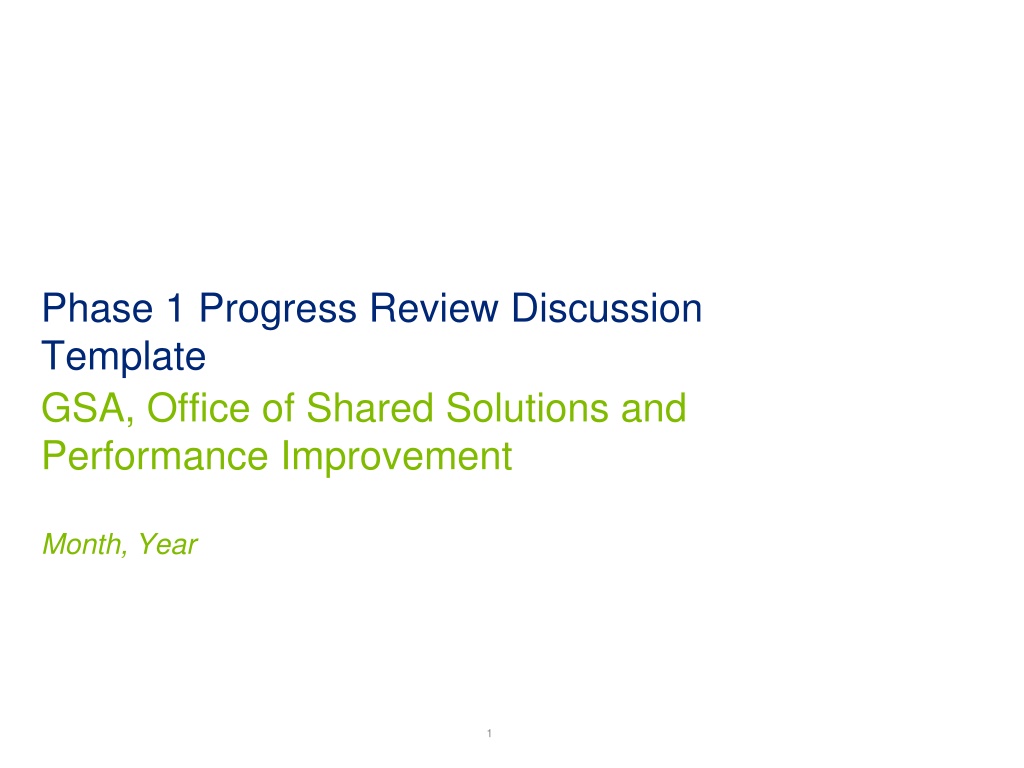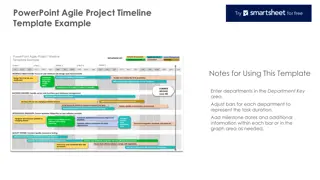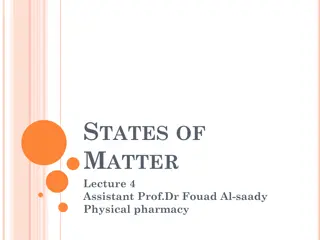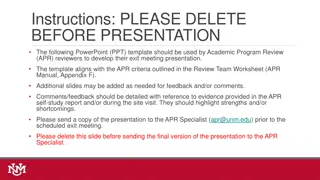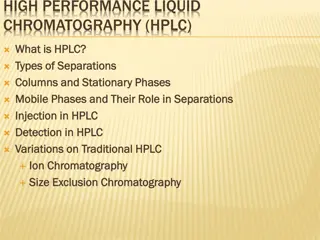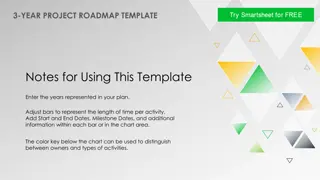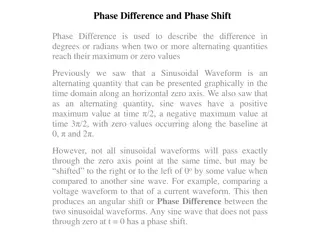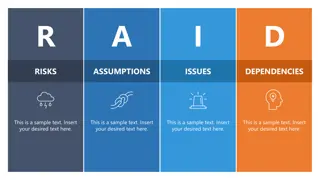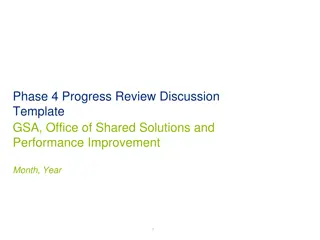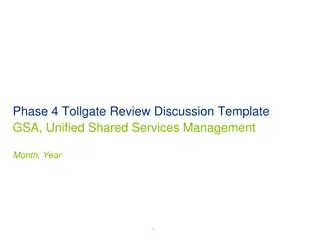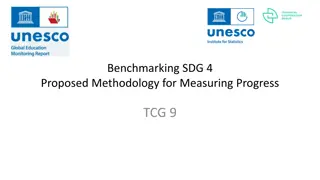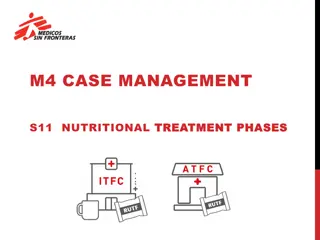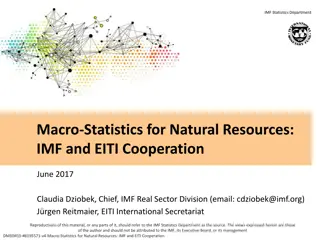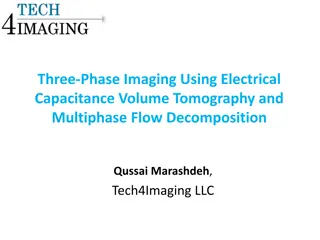Phase 1 Progress Review Discussion Template
This template supports progress reviews and discussions at the GSA Office of Shared Solutions and Performance Improvement. It provides a structured framework for assessing progress and identifying areas for improvement.
Download Presentation

Please find below an Image/Link to download the presentation.
The content on the website is provided AS IS for your information and personal use only. It may not be sold, licensed, or shared on other websites without obtaining consent from the author.If you encounter any issues during the download, it is possible that the publisher has removed the file from their server.
You are allowed to download the files provided on this website for personal or commercial use, subject to the condition that they are used lawfully. All files are the property of their respective owners.
The content on the website is provided AS IS for your information and personal use only. It may not be sold, licensed, or shared on other websites without obtaining consent from the author.
E N D
Presentation Transcript
Phase 1 Progress Review Discussion Template GSA, Office of Shared Solutions and Performance Improvement Month, Year 1
Questions to be Answered This template is intended to guide a Progress Review discussion between a Customer, Provider and Key Stakeholders. Questions to Be Answered Does the scope and operational end state make sense? Does the agency s business plan align with federal strategy and target outcomes? Is there a valid need for the investment? 0. Assessment Were alternatives considered (if shared services is not the strategy)? Does the organization understand the trade off between benefits and risks associated with the modernization or migration? How reasonable is the preliminary total migration cost? What language should be included in pass-back? Does the investment incorporate new or existing policy? Is it a result of new or existing policy? Does the effort align with each office initiative? Has the Life Cycle Cost Estimate (LCCE) been updated to reflect business capabilities, and is it reasonable? 1. Readiness Do the high-level capabilities identified by the agency meet the standard capabilities identified by the Service Area Managing Partner? Are any additional capabilities justified by mission needs or regulation? How inclusive is the risk analysis? Is the program adequately resourced (funding and people) to support due diligence and engagement with a provider? Does the program have adequate plans to mitigate critical issues and risks and contingency plans? Has the customer demonstrated robust planning in order to conduct due-diligence with providers? Does the organization have an general understanding of what the benefits of the program would be? 2
Instructions for Completing This Template This template is intended to guide a Progress Review discussion between a Customer, Provider and Key Stakeholders. To use this template: Use the source documents included within each slide to develop summary-level information that will help guide the Progress Review Be prepared to discuss specific questions/content included on each slide before or during the Progress Review Once complete, schedule a Progress Review meeting 3
Documentation Required for Phase 1 Progress Review The following documentation is required in guiding a discussion to demonstrate readiness and gain approval for Phase 1. Agencies purchasing transaction processing services only will identify relevant activities and artifacts for their project using the M3 Services Tailoring Guide. Information Contained in Progress Review Discussion Phase 1 Documentation Acquisition Strategy Baseline and Target Performance Success Metrics Defined Business Capabilities Business Readiness Assessment Change Management and Communications Approach Data Management/Data Quality Approach Initial Master Schedule Overview Investment Readiness Checklist IV&V Plan LCCE Market Research M3 Risk Assessment Tool Program Governance Model Project Business Case Resource Management Plan Scope of Services Overview Top Risks Acquisition Strategy As-Is Systems Environment As-Is Workforce Documentation Baseline and Target Performance and Success Metrics Business Capabilities Business Needs Workbook Business Readiness Assessment Change Management Plan Change Readiness Assessment Communications Plan Data Cleansing Plan Data Governance Model Governance Plan Independent Verification & Validation (IV&V) Plan Initial Master Schedule Investment Readiness Checklist Life Cycle Cost Estimate (LCCE) M3 Risk Assessment Tool Migration and O&M training needs Program Charter Program Management Plan Project Business Case Quality Assurance Surveillance Plan (QASP) Requirements Management Plan Resource Management Plan Risk Management Plan Risks, Actions, Issues, and Decisions (RAID) Log Stakeholder Analysis Status Reports/Dashboard Target State Concept of Operations Target State Systems Environment Workforce Assessment Exit Criteria (to move into Phase 2) Acquisition Strategy Baseline and Target Performance Success Metrics Defined; Aligned with Performance Framework Change Management Strategies Defined Completed Business Readiness Assessment Completed Project Business Case Confirmed Alignment of Business Capabilities against FIBF Data Quality Assessed Initial Master Schedule Defined Initial QSMO Marketplace Research Conducted Investment Readiness Checklist LCCE Developed Mitigation Plans in Place for Major Risks/Issues PMO and Governance Structure Defined Resources on-boarded Risks and Issues Management Defined 4
M3 Risk Assessment Tool Determine the risk rating at the end of Phase 1 using the M3 Risk Assessment Tool and submit with Progress Review material. 5
Business Readiness Assessment Provide an overview of the Business Readiness Assessment performed at the beginning of Phase 1. Provide a summary of the Business Readiness Assessment, which should include outcomes from: Assessing the Existing Solution Defining the Target End State Gap Analysis Source Documentation from Playbook Business Readiness Assessment Template 6
Initial Master Schedule Overview Provide an overview of the Initial Master Schedule as of Phase 1 Provide a summary of the Master Schedule timeline, which should include: Major activities and critical path milestones over the lifecycle of the program Expected Progress timeline Schedule constraints (e.g., contract end dates, system retirements) Whether activities and milestones are on- or off-track **Provide information by month and year Source Documentation from Playbook Initial Master Schedule 7
Life Cycle Cost Estimate (LCCE) Provide the estimated cost based on the LCCE*. Develop the life cycle cost information for Phase 1 based on any changes or refinement in scope of the program from when the Project Business Case was developed Estimated Costs for Migration and Operations and Maintenance (O&M) Responsible Party (Provider, Agency, Other) Migration Cost Category / Work stream Required FTEs Notes/Assumptions Total CPM FY N CPM FY N+1 CPM FY N+2 CPM FY N+3 CPM Cost Calculation Program Management Support Data Conversion Support Change Mgmt./Train Business Process Reengineering Systems Engineering <Project or Organization Determined> Total Migration Provider <Service Layer 1> Provider <Service Layer 2> Agency <Agency Cost> Total O&M Grand Total *To avoid duplication of effort, agencies are encouraged to use their existing budgetary documentation, when available, to provide cost estimates. Source Documentation from Playbook 8 LCCE
Resource Management Plan Overview Provide an Organization Chart and indicate required number of full time equivalents (FTEs)/resources, existing resource gaps, and plan to fill resource gaps Include the following: The roles and responsibilities needed for the customer migration team in Phase 2 Total number of resources needed and total number of resources staffed The percentage of time required for each position on the customer migration team Vacant positions and plan to fill each position For each role, indicate if resources are in an acting, detailed, or contractor-filled position Source Documentation from Playbook Resource Management Plan 9
Market Research & Acquisition Strategy Provide the details around market research and planned procurements to support the migration Potential data points could include: An overview of the approach to conducting market research to select a provider, including how QSMOs, Requests for Information (RFIs) and Provider Agreements will be used to further market research efforts and ultimately select a provider Potential additional support needed based on resourcing plan, legacy system support needs, data cleansing, and Independent Verification and Validation (IV&V) Expected Period of Performance Planned Procurement (including Scope) Acquisition Strategy Planned Contract Value Expected Award Date Status* Data Conversion: Provide services to extract and translate data from legacy application *Statuses may include: Early Planning, Requirements Defined, Request for Proposal (RFP) Released, Award Complete Source Documentation from Playbook 10 Acquisition Strategy
Independent Verification and Validation Plan Describe the program s approach for onboarding and utilizing IV&V support Provide an overview of: Timeline to obtain IV&V support The scope IV&V activities that will occur during the program The timing of IV&V activities during the program The process to address IV&V feedback IV&V relationships (i.e., who the sponsor is, and how IV&V support will interact with the provider, and OSSPI) Source Documentation from Playbook IV&V Plan 11
Program Governance Model Describe the program s governance model Consider including the following: The governance structure, which identifies the roles, responsibilities, and which offices are represented The process, cadence, and timeline to make decisions The process and criteria used to escalate decisions, issues, and risks The scope of the governance (i.e., whether or not the program manager has the authority to approve changes that do not extend the schedule, the maximum dollar value of the costs, and increases or decreases to the scope) Source Documentation from Playbook Governance Plan 12
Scope of Services Overview Describe which services the organization desires for migration and Operations and Maintenance (O&M) Migration O&M Describe required migration services (e.g., training, data conversion, systems integration) from the provider Describe required O&M services, including: Desired service (e.g., Financial Management, HR, Acquisition) Function (e.g., Payable Management) Description of selected service layers (i.e., system platform, transaction processing, business application support) Source Documentation from Playbook Business Needs Workbook 13
Change Management and Communications Approach Describe the stakeholders that will be impacted by the migration Consider including information on the following: The process for identifying impacted stakeholders Analysis of stakeholder awareness by the community Communications best practices that the stakeholder community will use Source Documentation from Playbook Communications Plan Change Management Strategy 14
Data Management/Data Quality Approach Provide an overview of the data management and quality approach including an overview of findings from the initial data assessment Consider including information on the following: The results of your data quality assessment Data cleansing activities that have already begun The timeline for future data cleansing activities Success criteria used to measure data quality Source Documentation from Playbook Data Governance Model Data Cleansing Plan 15
Baseline and Target Performance Success Metrics Agencies may use existing federal-wide benchmarks available at https://benchmarks.gsa.gov/ or create their own. Below are sample Performance and Success metrics by service area. 16
Top Risks Provide the top 5 10 risks identified during Phase 1 and proposed mitigation strategies Risk Impact Probability Owner Mitigation Strategy <Dedicate additional resources to support data cleansing efforts no later than 5/5> <Secure contractor support for data cleansing> <Risk 1: If adequate resources are not dedicated to data cleansing, then cleansing activities will be delayed and the quality of the conversion will be reduced> High Medium Program Manager Source Documentation from Playbook Risks, Actions, Issues, and Decisions (RAID) Log Risk Management Plan 17
Project Business Case Provide an overview of the Project Business Case developed throughout Phase 1. Provide a summary of the Project Business Case, which should include outcomes from: Outputs Vision Scope of services Expected benefits High-level timelines Investment information Risks Activities and outcomes Performance targets Source Documentation from Playbook Project Business Case Investment Readiness Checklist 18
Next Steps Please describe the activities planned for the next 30, 60, and 90 days 19
